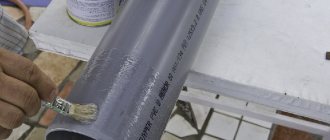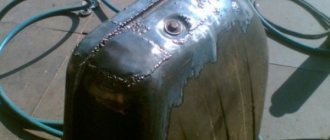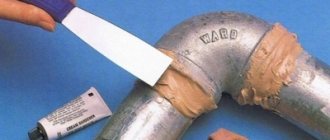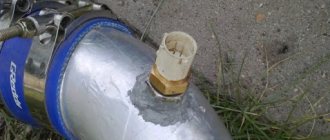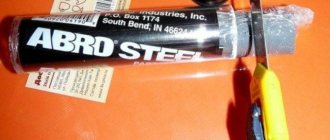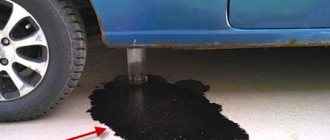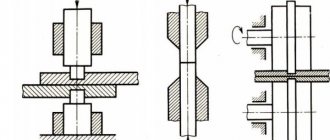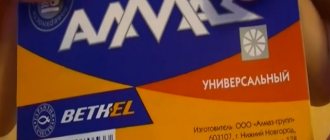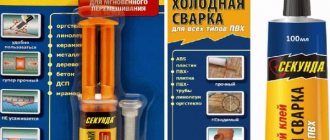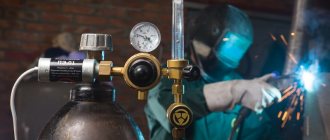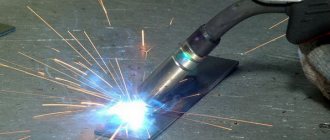Welding description
Cold welding refers to the treatment with polymer glue, which helps create reliable seams between the same or different materials without the use of heat. As a result, an integral connection of the elements is achieved, this is facilitated by the special composition of the chemical mass. The plastic agent penetrates into the parts being welded, then hardens, forming a monolithic joint.
Cold welding includes the following main components:
- epoxy resin;
- amine resins;
- steel fillers;
- minerals.
Epoxy glue is great for plastic, metal, wood, but you need to study the instructions in detail. Universal compounds can indeed be used on any material; highly specialized ones are only allowed to glue one type of element, otherwise the work efficiency will decrease.
Types of Cold Welding for Plastic
Cold welding for plastic comes in three main types. The first is the rod in which the two main components of the composition are connected. This rod contains one component inside, and a second component covers it externally. To prepare it for use, just mix everything to obtain a homogeneous consistency.
Cold Welding Rod for Plastic
The second type is the option where the two components are supplied in separate containers. To use, you need to measure out an equal amount, and then start mixing. As in the previous version, here you need to obtain a homogeneous consistency, which will then be used.
Cold-cooking adhesive for plastic
The third option is a liquid substance that looks like ordinary glue. It is not used as often as the previous two, as it is inferior in technical characteristics. It does not require special preliminary preparation and is immediately ready for use.
Cold welding adhesive for plastic
Advantages of liquid welding
A huge advantage of the product is the ability to repair almost any plastic product without heating, so the work does not require the use of instruments, welding equipment, special knowledge or long preparation. You cannot do without a cold compound when joining complex parts or when installing fire-hazardous or explosive structures. The tightness of the seams will be impeccable, so they will not allow moisture to pass through.
Other advantages of using cold welding:
- waste reduction;
- affordability and availability in stores;
- the ability to work even in “field” conditions (no need for electricity);
- highest adhesive strength;
- the ability to connect parts that experience vibration, shear and tear, thanks to good elasticity.
Almost any welding is water-resistant, high-temperature - universal compounds can withstand up to +260 degrees of heating during operation, specialized ones - up to +1000 degrees.
What does cold welding consist of?
The cold welding adhesive composition includes:
- Metal dust is a filler.
- Epoxy resin – provides the plasticity of the mass.
- Additives – different options are used for each material.
- Hardener
The reliability of cold welding is determined not only by its composition, but also by the cleanliness of the joined surfaces with which to work. If the instructions for diluting the glue and the degreasing conditions are met, you don’t have to worry about the strength of the adhesive seam.
However, it is necessary to understand that “cold welding” adhesive is advisable to use for small home repairs. For serious welding structures, such a connection is not suitable.
Cold welding - variations and varieties
In simple terms, cold welding is a plastic adhesive substance, the base of which is predominantly epoxy resin. Everyone has heard about its remarkable properties more than once.
Like epoxy resin, cold welding consists of a couple of components. However, there is a ready-made composition in “one bottle”. In this case, it must be used as quickly as possible, otherwise you may miss the moment and the glue will lose its qualities. Pay attention to the storage conditions and time of use of one-component formulations.
It’s a little easier with the two-component glue option. Two-component “Cold Welding” can be stored for a long period of time. Plus material consumption as needed. However, before use, it is necessary to make a high-quality knead in strict proportions.
Typically, manufacturers offer cold welding in a cylinder format. Its outer shell serves as a hardener. Inside the cylinder there is epoxy resin mixed with metallized dust. Metal dust added to the hardener hardens and reinforces the composition. In this way it is formed, increasing resistance to temperatures and mechanical damage.
A metal additive is required to give the finished clutch the highest level of strength. Cold welding also contains other additives that give the substance and finished joints unique strength parameters. The main range of additives is kept in the strictest confidence by manufacturers. However, it is known that sulfur is an integral component of cold welding from any manufacturer.
To a greater extent, cold welding is classified by grade depending on the scope of application. In other words, depending on the materials to be glued, cold welding includes specialized additives. Three main types of this substance are used with great success.
Cold welding for metal
It is actively used not only by home craftsmen, but also by motorists, since it provides a quick and effective solution to many problems associated with the use of motor vehicles.
Using cold metal welding, a radiator leak is eliminated, the oil pan is “welded,” and the cylinder head is also welded. Of course, such breakdowns require proper repair. But what to do if you are outside the city at the dacha?
Far from a car service, a temporary solution to the problem may be the best way out of the situation. This kind of glue will never be out of place in your toolbox. Household cold welding can last until you get to the nearest service center.
The grip obtained through cold welding provides a chance to forget about the difficulty that has arisen, at least for a while. Refurbished parts can be used for quite a long period of time. If you move quietly and carefully, there should be enough time to reach a qualified technician.
Household application of cold metal welding
Cold welding also works well when it is necessary to join parts that do not experience significant stress during operation. For example, this welding option is also used to repair plumbing fixtures, when it is necessary to quickly and firmly seal a leak. Areas where cold welding for metal is successfully used:
- Water pipes.
- Heating radiators.
- Pots with holes, if their further use does not involve cooking..
- Repairing chips in cast iron or metal bathtubs.
As it hardens, cold welding stops responding to the high temperature of use of the devices. If everything is done according to the instructions for use, then the glued objects can be used for their intended purpose for a short period of time.
Please note that cold welding adhesive is not intended for restoring food-grade cookware. Cold welding contains epoxy resin, which releases substances harmful to human health.
There is specialized cold plumbing welding. The adapted composition is not susceptible to the negative effects of a humid environment. As opposed to conventional adhesive, cold welding for plumbing is used in joints to seal wet joints. The characteristics of the composition of plumbing welding allow it to set even under water, holding it securely on the surface.
Read also: Adapter from ashdimiai to tulips
However, no matter how strong this adhesion option may be, cold adhesive welding can only temporarily solve the problem. As soon as a suitable case arises, it is imperative to measure the pipe.
Cold welding for plastic
This variation of cold welding is much less common, which cannot be said about metal welding. The reason for this is simple. All applications of cold welding for plastics have been replaced by the more efficient glue gun. The glue gun provides reliable hot gluing, firmly securing plastic products.
However, cold welding for plastics is useful for repairing plastic parts when there is no glue gun or there is no electrical network for its operation. Typically, cold welding is used for joining plastic pipes or other polymer surfaces.
Cold welding for plastic is widely used in industrial plants. Cannot be replaced in everyday life for home repairs. Try using cold welding adhesive to repair a plastic pipe and you will forget about the breakdown for a long time.
Cold welding for linoleum
Cold welding used for joints between linoleum and rubber deserves special attention. Simply an irreplaceable thing during repairs and finishing work. The quality of joints processed by cold welding for linoleum is many times superior to double-sided tape or liquid glue. As a rule, cold welding for linoleum is used only at joints. The high cost of the glue does not allow its use over the entire surface.
When joining sheets of linoleum, cracks always remain, which dry out over time and become more noticeable. A one-piece seam, which is produced using the cold welding method, can correct the situation. As a result, the connected sheets of linoleum look like a homogeneous canvas. And a seamless connection looks more aesthetically pleasing.
The result of the interaction of linoleum with glue is a chemical reaction. The material at the joints becomes soft and almost liquid. After the joints harden, the connection becomes strong and invisible. Cold welding is a fairly easy way to join linoleum. Even a novice master without the skills and professional tools for soldering linoleum (soldering iron, etc.) can complete the work.
Cold welding can also be used when there is a need to join parts made of hard rubber. Such details can be, for example, pieces of linoleum. Of course, this welding option is very widely used for construction work and simply for repairs.
It is important to note that the adhesion of linoleum formed by cold welding significantly exceeds in parameters those often formed using ordinary adhesive or double-sided tape.
Note that in this article only the most popular types of cold welding were identified. But there are several other less popular types in the industry. For example, this is welding for plumbing or concrete. There is also a universal option.
Be that as it may, all options can boast decent speed and gluing strength. Of course, only when during the work all the indicated rules in the instructions for use were strictly observed. Otherwise the clutch will soon fall apart.
Application of cold welding for metal products
A welding manual for metal products is provided as standard in each cylinder containing the material. Its use is almost no different from other types of this composition. However, before work, you should not neglect it.
To better understand how to use this glue, it is enough to consider in detail an example of repairing a hole in a pipe or a container made of metal. The big advantage of cold welding is that it can be used regardless of whether the container is empty or full. And even when the item being repaired is under pressure.
Simply put, if you, for example, need to repair a hole in a car radiator, there is absolutely no need to drain the liquid from it.
How to work with cold glue
During work, it is important to strictly follow all instructions. This is the only way to achieve the highest quality and strongest possible grip. The sequence of repair work by cold welding is as follows:
Initially, you need to prepare a working base where the adhesive composition will be applied. Clean from dirt and other things. Fine-grit sandpaper is perfect for this purpose. Preparation must be done with utmost care. The base must be perfectly clean.
It is easier to determine the degree of cleanliness by scratches on the surface that were caused by sandpaper. It is worth noting one more feature - the more such scratches there are, the more reliable the connection will be in the end.
Next, it is important to thoroughly dry the surface that you plan to treat. For this purpose, it is quite acceptable to use an ordinary hair dryer. No special technological devices are required for this. Of course, cold welding can also glue a wet surface. But in this case you should not count on a decent level of reliability of such a clutch.
Area of application of the material
There are a lot of plastic items, and almost all of them can be repaired using cold welding technology. It is possible to repair the connector of a household appliance, restore its individual parts, and repair various defects and chips. Cold welding is used to fill any cracks and carry out cosmetic and full repairs of the following products:
- pipes made of heat-resistant and ordinary plastic;
- fishing rods, tourist equipment;
- instrument bodies and handles;
- car bumpers, plastic interior elements;
- gardening, household, household equipment, etc.
Universal connection tool
This product is intended for joining products made of plastics, metals, stone, wood without thermal effects on the fixed elements. The original chemical composition of the products ensures a sufficiently high-quality and reliable connection of elements.
Cold welding technology does not involve heating, melting or cooling of workpieces, which allows you to create joints without disturbing the original characteristics of the materials.
Liquid welding is a universal tool that has found application in various fields - industry, everyday life, construction, instrument making, electronics. In structures not subject to critical stresses, it can successfully replace spot welding.
Among other things, liquid welding is an ideal sealant used to reliably seal the housings of various devices.
Application of liquid welding for plastic
Among the wide range of different brands of liquid welding there is a product designed for joining and repairing plastic products. The substance can be used for the following operations:
- elimination of defects, leveling and filling of car bumpers;
- repair of household appliances and plastic parts;
- sealing cracks and chips in pipelines;
- repair of fishing gear;
- connection and repair of plastic elements and parts of various shapes and purposes.
Due to its universal characteristics and properties, the product can be used to work with various types of plastics and other materials.
Types of cold welding
Depending on the consistency, all welding media are divided into liquid and plasticine-like. In the first case, they are sold in vials, bottles, boxes, in the second, the packaging resembles an adhesive stick, a cylindrical rod, or a tube.
The composition of the material is:
- one-component;
- two-component.
One-component welding is always liquid and has a consistency similar to office glue. It is used for joining small, lightweight parts, since the adhesive properties are not very powerful. Two-component welding is a more reliable composition. Before work, the resin is mixed with the hardener by combining the liquid components or manually mixing the plasticine-like mass. Once the chemical reaction begins, the user has a few minutes to carry out the work, otherwise the material will harden.
Using Cold Welding to Bond Plastic
Cold welding is a means for permanently connecting parts made of metal, wood, plastic, and concrete.
Cold welding is a means that is designed to permanently connect parts made of different materials.
Cold welding for plastic is widely used by builders, plumbers, and motorists. The fast and reliable connection method makes it easy to repair household appliances, car bumpers, plastic pipelines, fishing rods and other plastic items.
Cold Welding Characteristics
The parts are connected without heating. The principle is based on a chemical process. The plastic adhesive mass penetrates the surfaces being welded and after some time hardens, forming a monolithic seam. The process does not require expensive equipment or lengthy preparation.
Plasticine cold welding needs to be softened before use.
Cold welding is a polymer adhesive that contains epoxy resins, metal filler, and various chemical additives. Cold welding can be one- or two-component. Based on consistency, types of welding are divided into liquid and plasticine. Liquid ones consist of glue and hardener. Before use, the components are mixed. Plastilion-shaped ones can be either one-component or two-component. In the second case, the components are thoroughly kneaded and mixed, entering into a chemical reaction with each other.
Depending on the purpose, welding can be universal or highly specialized for a specific material. Specialized options are more durable than universal ones, but it is necessary to study exactly what they are intended for, otherwise the effectiveness will be zero. The composition for gluing plastic or wood is absolutely not suitable for metal.
The buyer may also be interested in the temperature conditions that cold welding can withstand. It must be indicated on the packaging. As a rule, inexpensive products with a wide range of applications have a temperature of about 260°C. For expensive narrow trains it is 4-5 times higher.
Return to contents
Stages of joining plastic using cold welding.
The bonded surfaces need to be cleaned and degreased. Therefore, you will need acetone. Unless the composition is intended for use under water, surfaces must be completely dry. The glue adheres better to rough surfaces. They can be sanded with sandpaper. Do not neglect the preliminary preparation of the surfaces to be glued. It largely determines the quality of the connection.
Two-component compositions are thoroughly mixed. Liquid ones are diluted in the indicated proportions, plasticine-like ones are kneaded. When the components are mixed, a chemical reaction occurs with a slight release of heat. Unwanted sticking to your hands can be eliminated by lightly moistening them with water.
Apply the mixture to surfaces quickly. After 3 minutes it loses its qualities. If necessary, the surfaces to be glued are fixed with a clamp.
Complete hardening occurs after a few hours. The exact time is indicated in the instructions. After this, the seam can be machined, puttied or painted.
When working with cold welding, you must follow the recommendations of the product manufacturer as set out in the attached instructions.
They may differ for different compositions, and failure to follow the rules will lead to poor quality of the compound.
Cold welding for plastic is quite easy to use. But nevertheless, working with it requires compliance with certain safety rules. Do not allow the glue to come into contact with the mucous membranes of the eyes and human skin. You need to work in safety glasses and rubber gloves. If the product gets on your hands, wash them immediately. If glue gets into your eyes, you will need medical attention. It is recommended to store liquid welding in a dark, dry place out of reach of children and animals.
expertsvarki.ru
How to use welding
The instructions for use always describe in detail the process of mixing the components and applying the product. The proportions of hardener and resin must be strictly observed or the adhesion of the adhesive will decrease. The rules for surface preparation cannot be ignored. They need to be cleaned of dirt, treated with sandpaper, then degreased - wiped with alcohol and acetone. Without removing fat, it is impossible to reliably join the elements.
Next, the order of work will be as follows:
- mix the resin and hardener or mix the thick components together (the amount of mass must correspond to the area of the hole, defect, gluing area);
- knead solid components only with thick rubber gloves moistened with water; when ready, the mass will acquire a bright brown color;
- apply the product to the parts to be fastened, use a clamp, tourniquet, cord or elastic band to secure them;
- press the parts, leave for an hour;
- then wait for the time according to the instructions or immediately begin further processing of the product (carving, painting, drilling).
Instructions for use
The manufacturer's requirements for the work procedure may differ slightly from each other. The instructions for use will tell you how to use the adhesive. Most look like this:
- Before starting work, prepare your work surface. Treat with an abrasive material, then degrease the area where the glue is applied.
- Prepare the working mixture. To do this, knead the cold weld in your hands until you obtain a homogeneous brown mass. We allow slight heating of the mixture during the preparation process.
- Apply the finished product to the surfaces to be joined. For best results, fix the connection.
- Expect the compound to polymerize . At the end of the period, mechanical processing of the connection is possible.
The technology for connecting different surfaces has its own nuances. Let's get acquainted with the intricacies of processing some materials.
Pipes
Leaks in the heating or water supply system are a rather unpleasant thing.
In order not to expect complaints from neighbors below, we recommend using cold welding for heating pipes. First of all, it is necessary to carefully prepare the surface for processing, and then calculate the exact deviation of the perpendicularity of the faces. With an outer diameter of a polypropylene pipe of 40 mm, this figure should not exceed 2 mm. Seal the leak. A fixing tourniquet should be applied to the resulting connection. If all rules are followed, the leak will be eliminated. However, remember that this method is temporary and does not eliminate the need to replace the damaged pressure pipe.
Linoleum
Experienced specialists have been using cold welding for repair work for a long time. After all, the resulting connection is in no way inferior in its characteristics to the use of a device for the hot joining method . The tool for applying the working composition is a special gun, which allows you to use glue economically. To avoid damage to the coating, use masking tape.
If cold welding gets on the linoleum, do not try to wipe it off immediately. Wait until it dries completely, and then remove it with a utility knife.
Work should only be carried out in well-ventilated areas.
Various types of plastics
Before gluing plastic surfaces, we recommend heating them slightly - this will speed up the polymerization process of the seam .
It is acceptable to use liquid welding for plastic. When preparing surfaces, remember that additional irregularities can improve adhesion between the elements being joined.
Don’t forget about the aesthetic aspect - butt-joined parts cannot be welded beautifully. Perhaps you should consider replacing.
Security measures
After drying, the weld will be absolutely safe for humans and pets; it does not emit harmful fumes. But when working directly with epoxy resin, it is important to follow all safety measures. Do not allow skin contact with the material; before starting work, you should wear thick clothing and gloves. It is prohibited to work without personal protective equipment – masks, respirators. The room must have good ventilation; in extreme cases, open a window.
The welding mixture should not come into contact with dishes, food, or other items that are used in everyday life and for nutrition. If resin gets on your skin, wash it quickly with soap. Penetration of the composition into the eyes is a reason to consult a doctor after preliminary rinsing with water.
Expert advice
There are a number of useful recommendations that will help you complete the job with greater accuracy and efficiency:
- when repairing pipes and pipeline elements, you need to buy only a moisture-resistant composition, taking into account constant contact with liquid;
- cold welding does not stick well and adheres less well to a wet surface, so the base must be thoroughly dried before starting work;
- if you have to urgently repair a leak in a plastic pipe, the patch needs to be changed later - adhesion will not be sufficient;
- To harden the mass faster, you can use a hairdryer with warm air;
- when the instructions do not indicate that the welding can withstand regular vibration, it is worth additionally attaching a pad to the junction of moving elements;
- You should only buy products from trusted manufacturers who have been on the market for a long time;
- There is no need to use material that has expired; its quality has been reduced.
Cold welding for plastic pipes
In terms of the quality of the adhesive joint, liquid adhesive for diffusion cold welding of PVC pipes is not only not inferior, but also provides much better strength and tightness characteristics. The confusion of definitions - both installation and repair fastenings are called cold welding - should not be misleading: glue for welding polymer pipes is usually much more liquid and volatile and is applied with a brush, and repair cold welding of plastics, metal, ceramics, and so on is performed ductile and quite thick glue, often reminiscent of plasticine or thick putty.
Unlike repair cold welding, adhesive joints of plastic pipes are used both for new installations and for repairs. In addition to chemical adhesive joining, fusion welding is also possible; mechanical threaded and fitting connections; physical and chemical methods and combined. Adhesive cold welding in its pure form has both pros and cons. The main advantages of assembling PVC pipes using adhesive cold welding:
- Efficient, labor-intensive, quick assembly;
- No electricity is consumed, installation costs and material consumption are low;
- Compared to the number of leaks during mechanical and butt welding pipe joints, assembly using adhesive cold welding is in no way inferior, and with high-quality gluing and the use of good glue, it gives better results.
Compositions for joining PVC pipes and fittings (PVC and CPVC - from chlorinated polyvinyl chloride) provide diffusion cold welding. The glue “dissolves” the polymer base by approximately 30% of the thickness, and after polymerization the joint turns out to be monolithic and sealed, and at the same time smooth both inside and outside the pipe.
The process of cold diffusion is significantly influenced by operating conditions, especially the temperature and humidity of the environment. Construction adhesive for polymers differs from thick plastic cold welding compounds - the composition is more fluid, homogeneous and must be absolutely pure, without additives. The glue has volatile components and is contained in a hermetically sealed container. You can work with frost-resistant glue from – 15˚С to + 35˚С, but in hot weather the glue dries faster and this must be taken into account. Glue can be used to connect polymer pipes of any diameter - from 6mm pipes to large sewer diameters of 600mm. Cold welding type adhesive is also used for connecting pipes on fittings, using heat-shrinkable couplings, and in soldering socket joints.
Read more about the differences in the characteristics of adhesive seams with welded and mechanical ones (on threads and fittings):
- All mechanical connections require consumables, and sometimes it is difficult to select fittings. There are no energy costs, but assembly takes a lot of time, which leads to higher installation costs.
- Traditional welding of plastic pipes with a special apparatus produces strong joints, but at the cost of considerable energy consumption. Adhesive joints are made just as quickly, they are not inferior in strength to welded ones, but even when using expensive glue they provide an economic advantage. Approximate consumption: 0.1 liter of adhesive composition is sufficient for joining 120-130 sections of small diameter pipeline.
Adhesive welding of PVC pipes is possible in cramped conditions, with difficult access to the joint being repaired. Plus for pipe repair: glue welding does not narrow the lumen of the pipe, which is especially important for areas of small diameter; the internal passage remains smooth and does not become a risk factor for settling and accumulation of solid particles and blockages.
Suitable brands and selection rules
Welding for plastic has less stringent requirements than welding for metal. It is better to immediately buy a two-component composition with a high degree of reliability. The following welding methods have worked well:
- Poxipol;
- Super Epoxy Moment;
- Titanium;
- Skol;
- Diamond;
- EDP;
- Mastix;
- AVS Crystal;
- Second.
When choosing a material, you need to pay attention to the operating temperature. If the conditions are extreme, the welding must be able to withstand them. Also, the manufacturer always indicates the permissible pressure standards for the weld; if there is a discrepancy, the connection will break. If the repair takes a long time, it is better to buy long-hardening products; when gluing small parts, 3-5 minutes of time is usually enough for the composition to set. It is more convenient to glue thin parts with liquid agents; coarser work is usually carried out with thick materials, which are also used to level the surfaces of products.
Which brand should you choose?
These values are somewhat arbitrary, but, in general, they are optimal for the type of welding being described. Many brands that can be purchased at any hardware store meet these requirements. The leader here is two-component cold welding for plastic – “POXIPOL”. It is extremely reliable and at the same time affordable. Other products in this group under the following trademarks also perform well:
- EPOXY;
- EPD;
- MASTIX;
- AVS CRYSTAL;
- DIAMOND;
- SKOL;
- TITANIUM;
- SECOND.
POXIPOL
There is no one-size-fits-all advice when choosing cold welding for plastic. The only thing I can recommend is that if you need to make long-term repairs, buy long-hardening mixtures. If the task is to fasten small structural parts made of plastic, then a liquid adhesive composition is suitable.
